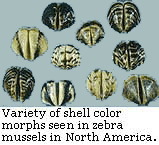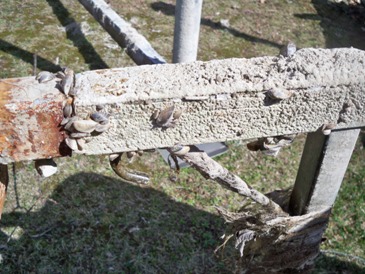Interesting Facts
-Zebra Mussels are reproductively mature within 1 year and
females can produce up to 30,000 eggs in first year of their
life.
-The shell of their trochophore larvae forms within 2 to 9 days
of fertilization.
-Zebra Mussels were most likely to be brought to America as larvae in
ballast of water of ships that traveled from fresh water Europe
to the Great Lakes.
-They were first found in Wisconsin waters of Lake Michigan in 1990.
-Zebra Mussels were first found in 1991 in the Pool 8 of the
Mississppi River.
-Zebra Mussels are only freshwater mollusks that can firmly
attach themselves to solid objects.
-In 2001, Wisconsin
Electric Power Company reported they were spending 1.2 mil a
year in control of zebra mussels on their Lake Michigan power
plants.
-They are the only freshwater bivalve that is known to have a free swimming veliger larva.
 -Zebra Mussels
are generally thought to only have striped patterns, but they
can range anywhere from all black, all white, and even tan.
-Zebra Mussels
are generally thought to only have striped patterns, but they
can range anywhere from all black, all white, and even tan.
-The invasion of the Zebra Mussels was
one of the most important invasion in
Biology.
-Zebra mussels
can tolerate only slight salinity. Although some populations of
European zebra mussels can be found in estuari es, their
persistence is only because of reduced tidal
fluctuation.
es, their
persistence is only because of reduced tidal
fluctuation.
-There are many methods that have been tested in order to control the spread of Zebra Mussels. Some of these methods work better than others depending on the situation.
-Chemical Molluscicides: Oxidizing (chlorine,
chlorine dioxide) and Non- oxidizing
-Manual Removal (pigging, high pressure wash)
-Dewatering/Desiccation (freezing, heated air)
-Thermal (steam injection, hot water 32oC)
-Acoustical Vibration
-Electrical Current
-Filters, Screens
-Coatings: Toxic (copper, zinc) and Non-toxic
(silicone-based)
-Toxic Constructed Piping (copper, brass,
galvanized metals)
-CO2 Injection
-Ultraviolet Light
-Anoxia/Hypoxia
-Flushing
-Biological (predators, parasites, diseases)
The Wisconsin
DNR has a great list of controlling
Zebra Mussels once they invade.
-Chemical control the most common treatment by
water utilities and power plants.
-Females can
lay over one million eggs in a spawning season.
-They can
withstand short periods (several days) out of the water if
conditions are moist and humid.
-They have a
saltwater relative, the dark false mussel (Mytilopsis
leucophaeata), which is native to the Atlantic coast. This
relative looks very much like the zebra
mussel and is often mistaken for it.
-Zebra Mussels could
possibly affect our drinking water. They
may promote the growth of a blue-green algae that produces a
toxin harmful to people and animals.
-Alternating dark and light stripes on their shells that range in color from brown to black and white to yellow.
-The external shell patterns in relevance to
other related species can be viewed on
this
page.
-After a Zebra Mussel dies,
its sharp shells wash onto shore and can
cause cuts when humans step on them.
-The Zebra Mussel's reproductive system is unique to freshwater
mussels. The different stages of the Zebra Mussels life cycle
can be viewed on the
adaptation
page.
-They require well oxygenated water with high levels of
suspended organic material and a reasonably hard substrate in
order to survive.
-Zebra Mussels require calcium in their diet in order to enable shell development.
Curious as to how Zebra Mussels interact with other organisms? View the interactions page to find out!